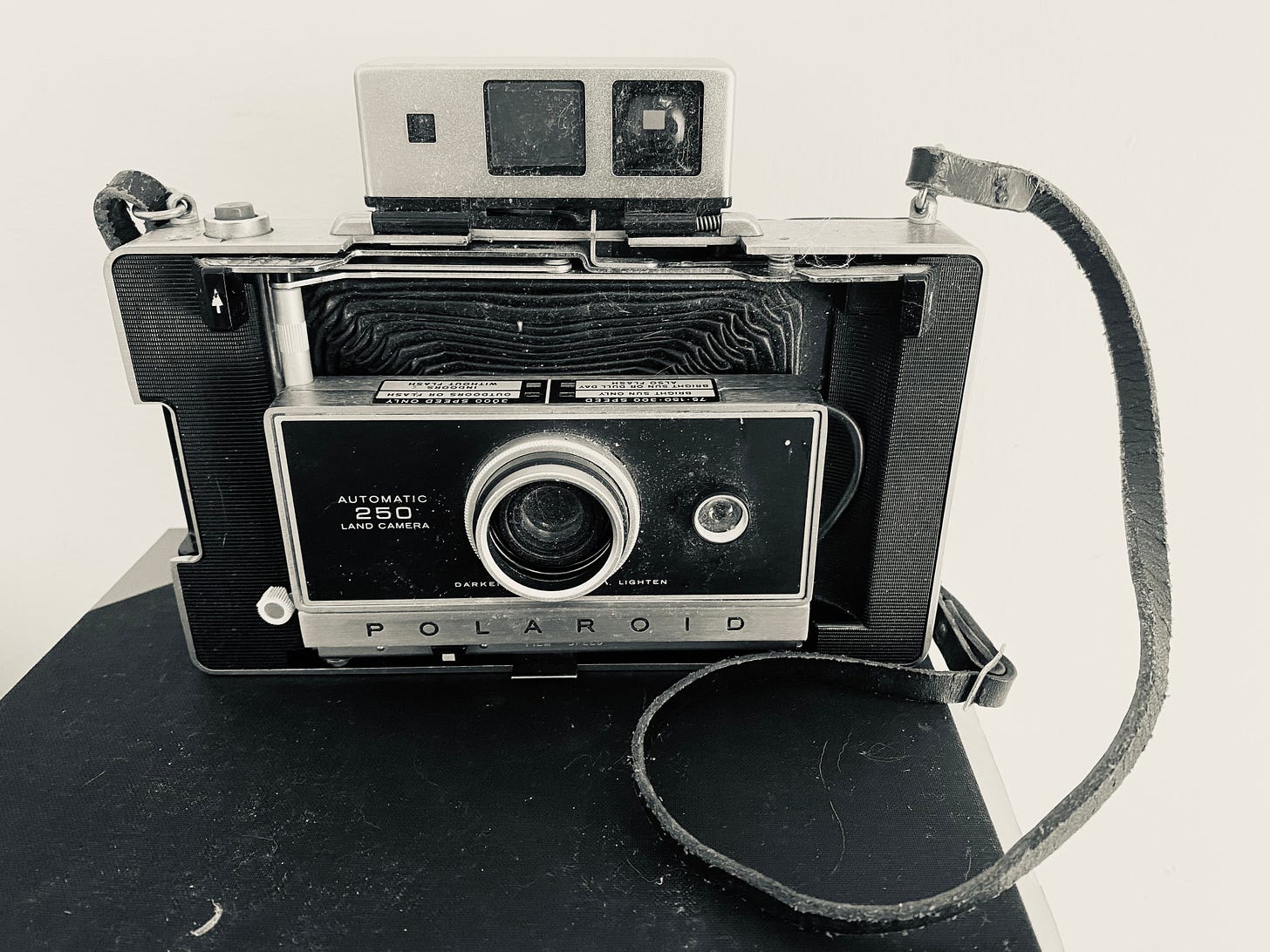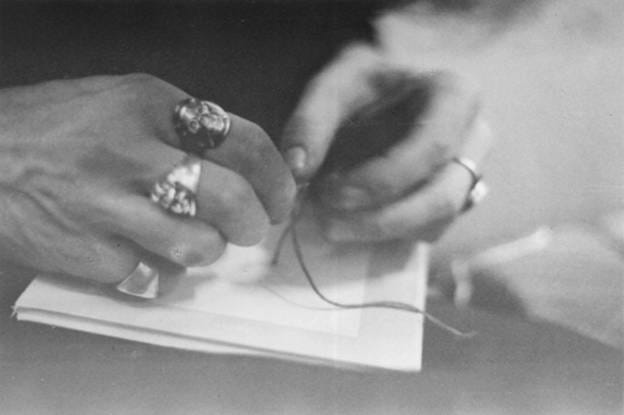Last week, I initiated 100 Cities to share Polaroids of cities that I have loved exploring. I started going through boxes, sorting images, when I found a few photographs I had taken of Robert Mapplethorpe’s hands at the Chelsea Hotel. The lighting was not very good, but they are from a time precious to me. I never took any pictures of his face. We were most always together and somehow it never occurred to me. Robert hadn’t started taking photographs, and when we wanted our picture taken we usually went to a photobooth on 42nd Street, where you could get a strip of four for a quarter.
For a time, I took photographs with an inexpensive 35mm camera that I picked up at a pawn shop. Most often I didn’t have the money to develop the pictures. I just liked taking them, freeze-framing a moment in time. I was, in part, as the young man in Alain Resnais’s film Muriel, just gathering information. Shots useful for a collage, to illustrate a poem, or merely pin on my wall of inspirational images. Most of those pictures vanished during several youthful moves, as I typically left much behind.
The earliest existing photographs I still have from that time are a few detail shots of the painting “Woman I” by Willem de Kooning. I fell in love with her at the old Museum of Modern Art, where she once held a place of prominence. As I wasn’t able to visit the museum very often and wanted a souvenir, I surreptitiously snapped her portrait. Very few people were taking photographs back then. It was too expensive and not yet commonplace. I remember only a handful of artists passing through the Chelsea with cameras. Diane Arbus, Judy Linn, Jonas Mekas, Dennis Hopper, Sandy Daley, and eventually Robert. When Robert started taking pictures I abandoned my camera. I had other pursuits on the forefront, and all our available money was invested in buying film for his work, which he took very seriously. I was fortunate to be his first model and privy to his photographic evolution.
When my husband died in 1994, I found it impossible to do anything creative, to write a single word. One afternoon when the children were at school, I noticed how lovely the light was and how it fell upon the mosquito netting over the window. Fred’s old Polaroid Land camera was on the shelf. I took two pictures that afternoon, both diffused in light. The first was Nureyev’s practice slippers and a second of the net falling on a Tibetan singing bowl. Just two photographs. But to me, proof of creative energy, some evidence that I yet existed as an artist.
When I went back on the road in 1996, my Polaroid camera became my trusted companion. Roaming foreign streets and taking photographs provided a sense of satisfaction in my solitude. The immediacy of the process—shoot, peel, reveal—amplified the pleasure of creating something on my own, a welcome departure from the responsibilities of touring. I had a happy run taking Polaroids until the film was withdrawn from the market. Although I dearly missed the process, I reasoned it an environmentally sound decision.
These days, I take most photographs with my phone. It doesn’t provide me with the aesthetic pleasure that my idiosyncratic Polaroid camera had, but it suits my needs. One can actually get really great pictures with a phone, the great equalizer. If Robert had lived, I would have certainly taken a picture of his hands with my phone, and then another of his face to capture his green eyes and his mischievous smile.











Patti, you are just a great human being. Imperfect, impermanent and incomplete -- that's what we humans are in our greatest sense of being human. I'm buoyed by your humor; you sitting in front of your bed in your bedroom with walls so empty it reminds me of my grandmother when I was young or my mother as she lay in bed almost dying last year in a room so barren of anything on the walls. Your photos are poems. Your fiery spirit, good boundaries, as I can attest, as once I asked you in a cafe if I could take your photograph and you were very clear about saying no, but you came back to my table and gave me your email address, saying you were, what was the word you used, hum, it might have been something to the effect that you are pretty accessible. I've come to see you like that, someone who is not lost in fame, above others, needing to see yourself as special in order to assuage some inner emptiness. You make us all feel like we are part of your life and your life is not that different from ours. Same emotions, same fears, same tears, same red blood and facing the inevitable. I've brushed past you a few times and swear we sat and talked in 1970 at the Chelsea one night, but I could have been on acid and it could have been someone else. One of the few photographs I've taken of you sits on my piano as encouragement to practice. The photo of me with Robert in Arles, taken by a fellow photographer during the 1981 festival, where we both showed, crumbled into dust from the sun--I placed it on my window sill over the summer one year. It blew away like ashes when a gentle breeze was unleashed one hot afternoon. He was certainly a shy guy. I loved his photos. They were displayed across an enormous screen one night in the old stone amphitheater. Huge photos that sometimes made me cringe. His sexually explicit masterpieces that are barely discoverable on google now. Beautiful and real and violent and poetic and powerful. His boyfriend, you would know his name, I never did, came up those cobblestone streets meant for Deux Chevauxs in his oversized convertible caddy, which took up the whole road and caused many villager's eyeballs to turn and wonder who is this blond American hunk. Thank you for being out there and letting us all feel we know you even a little. Warm Wishes -- grandma linda -- oh yes, that is my share. I'm in love. It's the most extraordinary thing to be a grandmother... never imagined I would fall in love again like this.
you are the most generous visionary and I cannot thank you enough for the many gifts you share so freely. it is always in my nature to give back, and I came upon a book recently that I feel you may enjoy: The Bloomsbury Group in Berwick Church. as a fellow Bloomsbury/Charleston Farmhouse enthusiast I have made a number of pilgrimages to Sussex to immerse myself in an environment that never fails to inspire. the paintings at the Berwick church are incredible, and this book explains how this eclectic group of atheists were able to produce profoundly beautiful decorative paintings in a house of worship. Berwick Church has been refurbished since i last visited in 2019 and I am so eager to return after reading this book to see it with new eyes!